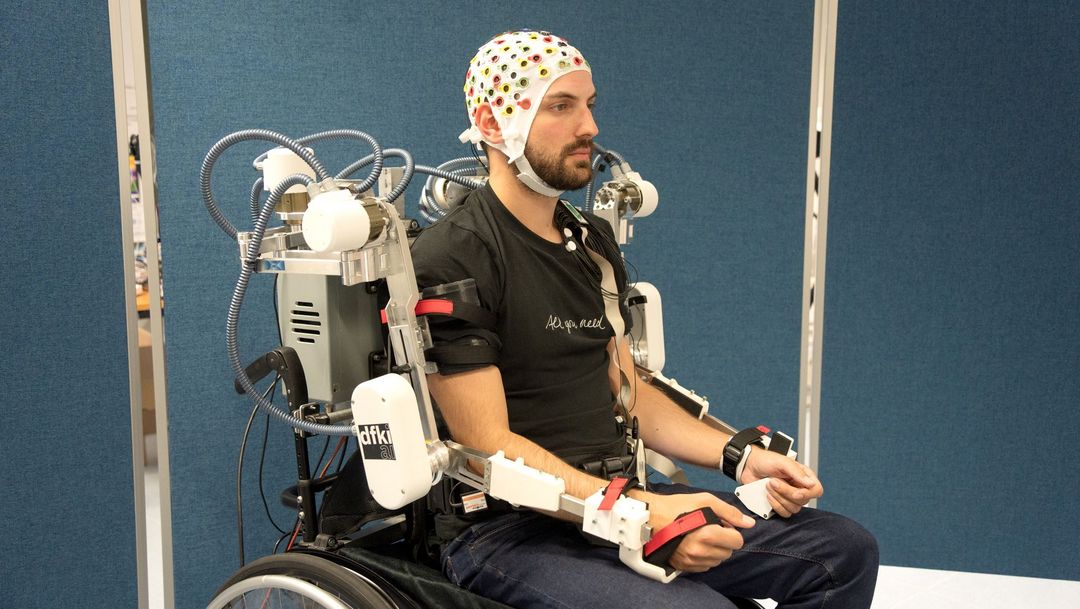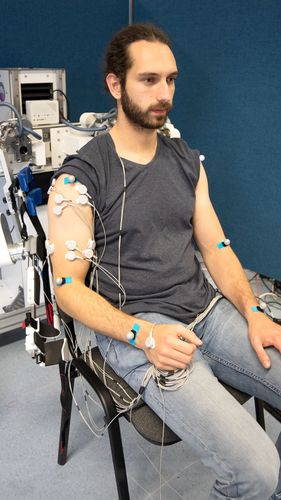
The future of personalized robotics: DFKI optimizes system development with hybrid AI and human feedback
| Human-Machine Interaction | Robotics | Robotics Innovation Center | Bremen | Press release

Increasing digitalization, powerful hardware and AI-based data processing are creating the conditions for robots to become the flexible and safe AI assistants of the future. They will need to be able to adapt to a wide range of environments and requirements, whether in manufacturing, logistics, care or everyday life. However, their acceptance depends crucially on the ability to customize them. This is where the recently completed M-Rock project comes in. As part of the X-Rock developments at the DFKI Robotics Innovation Center, M-Rock builds on the results of the D-Rock and Q-Rock projects and contributes to the overall goal of X-Rock: To enable people without expert knowledge to design customized robots for their applications.
Integrating human feedback into system design
While D-Rock focused on building an extensive database of modular robot components, the approach developed in Q-Rock enables the automatic mapping of complex hardware and software structures to specific robot behaviors using hybrid AI methods such as machine learning and structural reasoning. M-Rock extends this approach by integrating human feedback to not only adapt the behavior to individual user requirements on the software side, but also to enable subsequent optimization of the behavior and hardware selection. The project thus provides not only a solution for the continuous adaptation of robots during operation, but also a tool for the personalization of robot design and behavior.
 © DFKI, Annemarie Popp
© DFKI, Annemarie PoppStudies show the benefits of explicit and implicit feedback
A key innovation of M-Rock is the combination of explicit feedback, such as scale ratings, with implicit feedback, such as brain and muscle activity (EEG and EMG data), to automatically adapt a robot to the individual needs and preferences of the interacting human. To investigate the role of human feedback, the researchers conducted four studies. They recorded EEG data from test subjects who observed errors in the robot's ongoing behavior and errors in the human's behavior. The researchers then analyzed the data for the so-called error-related potential, which is triggered in the human brain when errors are detected.
Further studies collected both implicit and explicit feedback. In one study, subjects perceived the incorrect behavior of a worn elbow orthosis; in the other, subjects perceived the incorrect behavior of a pendulum robot. The analysis of the EEG data showed a high accuracy of error-related potential detection in all studies. It was shown that implicit feedback can be used to detect errors in real time, whether in robots, human movements, or orthotics. This in turn can be used by the system to make automatic adjustments without the need for active user intervention.
Optimal Cognitive Cores generate natural robot motions
Another achievement of M-Rock is the further development of the Cognitive Cores (CCs) introduced in Q-Rock into Optimal Cognitive Cores (OCCs) using methods of optimal control. OCCs enable the generation and execution of natural behaviors for complex systems and improve human interaction by accurately describing robot tasks. They use mathematical models to find optimal solutions to complex control problems, taking into account factors such as energy consumption, time, and safety. In experiments with the RH5 humanoid robot, the researchers have successfully used OCCs to generate dancing and walking motions.
Human feedback can help improve the Optimal Cognitive Cores (OCCs) and refine the robot's behavior. It is used to create cost functions that help plan optimal trajectories. In this way, the robot learns which movements are efficient based on human evaluations and can better respond to dynamic environments.
 © DFKI, Meltem Fischer
© DFKI, Meltem FischerSuccessful evaluation of the developed methods
The technologies developed in M-Rock were evaluated in two application scenarios. In the first scenario, the researchers tested the so-called "assist-as-needed" approach of an exoskeleton that individually adapts the robotic support to the user. Subjects performed various arm movements while their muscle activity (EMG data) served as feedback for a neural network to predict joint forces. The results showed that the exoskeleton was able to assess the user's capabilities based on the EMG data and provide flexible and individualized support for each joint.
The second scenario focused on the joint optimization of behavioral and design parameters of a quadruped robot for jumping and backflips. Optimal Cognitive Cores (OCCs) helped to adapt the robot's movements to the task at hand and to select the optimal morphology. Tests on the real system showed that longer upper legs for forward jumps and longer lower legs for backward somersaults gave the best results.
The scientific results of the project have been described in more than 30 publications, including doctoral theses, articles in high-impact journals, and conference papers at internationally renowned robotics conferences.
M-Rock was funded by the German Federal Ministry of Education and Research from 01.08.2021 to 31.07.2024 under project code 01IW21002.
Contact:
Prof. Dr. Elsa Andrea Kirchner
- Elsa.Kirchner@dfki.de
- Phone: +49 421 17845 4113
Dr.-Ing. Dennis Mronga
- Dennis.Mronga@dfki.de
- Phone: +49 421 17845 6560